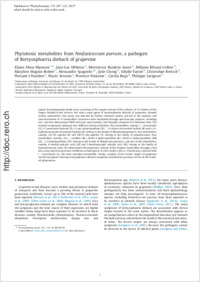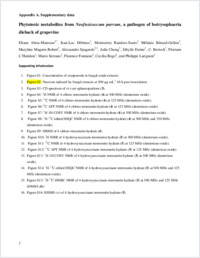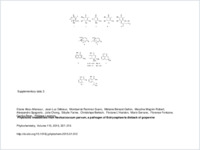Phytotoxic metabolites from Neofusicoccum parvum, a pathogen of Botryosphaeria dieback of grapevine
- Abou-Mansour, Eliane Department of Biology, University of Fribourg, Switzerland
- Débieux, Jean-Luc Department of Biology, University of Fribourg, Switzerland
- Ramírez-Suero, Montserrat Laboratoire Vigne Biotechnologie et Environnement EA 3991, Université de Haute-Alsace, Colmar, France
- Bénard-Gellon, Mélanie Laboratoire Vigne Biotechnologie et Environnement EA 3991, Université de Haute-Alsace, Colmar, France
- Magnin-Robert, Maryline Laboratoire Stress Défense et Reproduction des Plantes EA 4707, Université de Reims Champagne-Ardenne, Reims, France
- Spagnolo, Alessandro Department of Biology, University of Fribourg, Switzerland - Laboratoire Stress Défense et Reproduction des Plantes EA 4707, Université de Reims Champagne-Ardenne, Reims, France
- Chong, Julie Laboratoire Vigne Biotechnologie et Environnement EA 3991, Université de Haute-Alsace, Colmar, France
- Farine, Sibylle Laboratoire Vigne Biotechnologie et Environnement EA 3991, Université de Haute-Alsace, Colmar, France
- Bertsch, Christophe Laboratoire Vigne Biotechnologie et Environnement EA 3991, Université de Haute-Alsace, Colmar, France
- L'Haridon, Floriane Department of Biology, University of Fribourg, Switzerland
- Serrano, Mario Department of Biology, University of Fribourg, Switzerland
- Fontaine, Florence Laboratoire Stress Défense et Reproduction des Plantes EA 4707, Université de Reims Champagne-Ardenne, Reims, France
- Rego, Cecilia Institut Supérieur d’Agronomie, Tapada da Ajuda, Lisbonne, Portugal
- Larignon, Philippe Institut Français de la Vigne et du Vin Pôle Rhône-Méditerranée, France, Domaine de Donadille, Rodilhan, France
-
05.03.2015
Published in:
- Phytochemistry. - 2015, vol. 115, p. 207–215
Neofusicoccum parvum
Botryosphaeria dieback
Esca
Phytotoxins
Dihydrotoluquinones
Isocoumarins
Epoxylactones
Vitis vinifera cells (calli)
Defence gene expression
English
Liquid chromatography-diode array screening of the organic extract of the cultures of 13 isolates of the fungus Neofusicoccum parvum, the main causal agent of botryosphaeria dieback of grapevine, showed similar metabolites. One strain was selected for further chemical studies and led to the isolation and characterisation of 13 metabolites. Structures were elucidated through spectroscopic analyses, including one- and two-dimensional NMR and mass spectrometry, and through comparison to literature data. The isolated compounds belong to four different chemical families: five metabolites, namely, (−)-terremutin (1), (+)-terremutin hydrate (2), (+)-epi-sphaeropsidone (3) (−)-4-chloro-terremutin hydrate (4) and(+)-4-hydroxysuccinate-terremutin hydrate (5), belong to the family of dihydrotoluquinones; two metabolites, namely, (6S,7R) asperlin (6) and (6R,7S)-dia-asperlin (7), belong to the family of epoxylactones; four metabolites, namely, (R)-(−)-mellein (8), (3R,4R)-4-hydroxymellein (9), (3R,4S)-4-hydroxymellein (10) (R)(−)-3-hydroxymellein (11), belong to the family of dihydroisocoumarins; and two of the metabolites, namely, 6-methyl-salicylic acid (12) and 2-hydroxypropyl salicylic acid (13), belong to the family of hydroxybenzoic acids. We determined the phytotoxic activity of the isolated metabolites through a leaf disc assay and the expression of defence-related genes in Vitis vinifera cells cv. Chardonnay cultured with (−)-terremutin (1), the most abundant metabolite. Finally, analysis of the brown stripes of grapevine wood from plants showing botryosphaeria dieback symptoms revealed the presence of two of the isolated phytotoxins.
- Faculty
- Faculté des sciences et de médecine
- Department
- Département de Biologie
- Language
-
- English
- Classification
- Biological sciences
- License
-
License undefined
- Identifiers
-
- RERO DOC 257043
- DOI 10.1016/j.phytochem.2015.01.012
- Persistent URL
- https://folia.unifr.ch/unifr/documents/304506
Other files
Statistics
Document views: 103
File downloads:
- pdf: 295
- Supplementary material: 231
- Supplementary material: 209
- Supplementary material: 190



